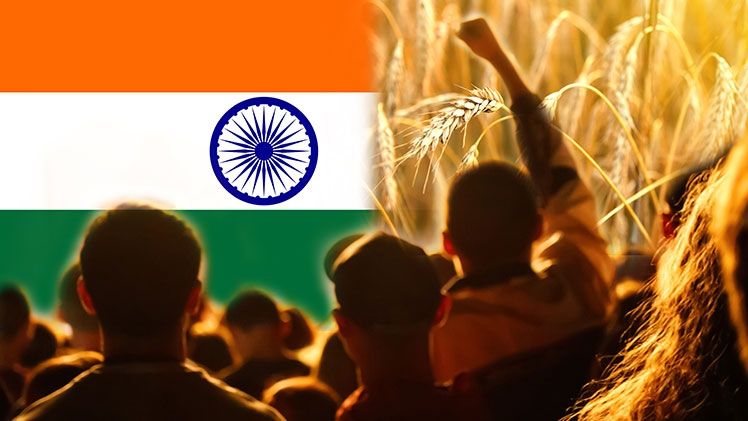As India’s general election nears, Narendra Modi faces anger from farmers
- 2024.07.03
- 0
- Download the publication (PDF - 269,55 KB)

Read the article
Indian farmers are at the gates of New Delhi asking the government to raise the minimum floor prices of the cereals they grow and extend the mechanism to all crops. It’s not the first time this type of protest has erupted in India, where nearly half the population still makes a living from farming.
Between November 2020 and 2021, Indian farmers spent nearly a year camped out around cities demanding that a law that liberalised cereal pricing be scrapped.
This time around, with a general election due to be held between April and May, the issue is even more important. While there’s little doubt as to the outcome, which should see Narendra Modi’s BJP party return to power and Modi begin his third term as prime minister, Modi’s handling of the crisis remains critical to his public image. In 2021, a crackdown on protests resulted in nearly 700 deaths. The farmers eventually returned to northern India (to the states of Punjab and Haryana, India’s main producers of rice and wheat) with the promise that a review commission would be set up to look at nationwide minimum floor prices for harvests.
Two years on, with no decisions made, anger is growing again. It should be noted that inflation has not spared India, affecting first and foremost energy products, of which the country is a net importer (oil accounts for around 25% of total imports), followed by food products and particularly vegetables, with crops of the latter increasingly affected by climate change. Over the past three years, India has had to cope with increasingly unpredictable monsoons, the timing of which is critical to harvests, as well as intense heat waves. The upshot is that, despite strong growth (7.2% in 2022 and 6.3% in 2023), real wages have failed to keep up.
This is down to India’s extremely informal labour market (90% of workers have no employment contract) combined with its heavily rural population: in particular, farmers have little leverage with which to negotiate higher prices.
Modi’s eyes are on industry
Despite the ongoing crisis in agriculture, fiscal policy remains focused on industry. Using India’s G20 presidency as a platform to attract new investors and promote India as an alternative to China, Narendra Modi has chalked up a few highly publicised successes, notably in the telephony field. Apple, Samsung and Google all now make some of their phones in India. Basic assembly lines have given way to more modern production facilities and the supplier network has expanded with the arrival of Taiwanese subcontractors.
Still a very protectionist country, India has embarked on a dual strategy of integrating itself into supply chains and substituting imports through the “Make in India” initiative, which aims to boost the share of manufacturing value added from 17% to 25% of GDP. Fourteen specific sectors, ranging from automotive to agri-food and electronics, are targets for public investment or tax breaks. However, the strategy is running into India’s shortcomings in infrastructure and logistics, especially compared with its rival China.
While China accounts for 14.7% of global exports, India accounts for only 1.8%, putting it on an equal footing with Vietnam. The existence of very high tariff and non-tariff barriers, the burden of red tape, endemic corruption up to the very top of government and the arbitrary nature of some public decisions all serve to dampen appetite among investors, who remain wary of moving into the country. Compared with its other Asian competitors (the Philippines, Malaysia, Thailand and, above all, Vietnam), India is let down by its relative lack of openness: businesses in the middle of supply chains, and thus liable to produce higher added value goods, are often hampered by the lack of adequate upstream industrial capability and difficulties importing the intermediate goods they need.
Investors interested in India are obviously not just looking for somewhere to put a production site: their eyes are on the country’s huge domestic market. India has dethroned China as the world’s most populous country but is still wrestling with endemic poverty, summed up by its inflation index: 50% of inflation is driven by food prices, which means food is often the largest item in household budgets.
While the industrial stakes – at the heart of the country’s medium-term development strategy – are high, Narendra Modi cannot long ignore the plight of farmers, who still make up the majority of India’s electorate. However, as the “world’s biggest democracy” prepares to go to the polls, it’s entirely possible that the prime minister could continue with his campaign of repression, which has curtailed freedom of expression and rights for some minorities while clearing the way for increasingly nationalistic and authoritarian rhetoric and measures. Against this backdrop, and with the opposition still struggling to organise itself into an effective alternative, farmers’ protests will more than likely continue to be repressed by force. When it comes to celebrating Modi’s future victory, tractors at the gates of New Delhi are presumably not part of the plan.

Despite the ongoing crisis in agriculture, fiscal policy remains focused on industry. Using India’s G20 presidency as a platform to attract new investors and promote India as an alternative to China, Narendra Modi has chalked up a few highly publicised successes, notably in the telephony field.
Sophie WIEVIORKA, Economiste - Asia (Excluding Japan)
